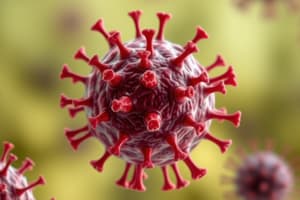Podcast
Questions and Answers
What is the role of superantigens in the immune response?
What is the role of superantigens in the immune response?
- They promote the differentiation of regulatory T cells.
- They enhance phagocytosis by macrophages.
- They hyperinduce inflammatory cytokines. (correct)
- They inhibit the production of cytokines.
Which T cell signaling pathway is crucial for regulatory T cell differentiation?
Which T cell signaling pathway is crucial for regulatory T cell differentiation?
- Mitogen-activated protein kinase (MAPK) pathway.
- Phosphoinositide 3-kinase (PI3K) pathway.
- T cell receptor signaling pathway. (correct)
- Nuclear factor kappa-light-chain-enhancer of activated B cells (NF-κB) pathway.
How do pentraxins function in the immune response?
How do pentraxins function in the immune response?
- By facilitating the clearance of pathogens. (correct)
- By preventing the differentiation of B cells.
- By neutralizing antibodies in the bloodstream.
- By initiating the apoptosis of immune cells.
What characterizes M1 macrophages in the immune response?
What characterizes M1 macrophages in the immune response?
What is the significance of macrophage polarization in tissue remodeling?
What is the significance of macrophage polarization in tissue remodeling?
Which cytokine profile is most commonly associated with M2 macrophages?
Which cytokine profile is most commonly associated with M2 macrophages?
What is the primary mechanism of pathogen recognition in the innate immune system?
What is the primary mechanism of pathogen recognition in the innate immune system?
Which of the following is a feature of humoral immunity?
Which of the following is a feature of humoral immunity?
What is the primary role of cytokines in the immune response?
What is the primary role of cytokines in the immune response?
In T cell development, what is the significance of the thymus?
In T cell development, what is the significance of the thymus?
What role do cytokines play in the immune system?
What role do cytokines play in the immune system?
Which of the following statements accurately describes T cell development?
Which of the following statements accurately describes T cell development?
What mechanism primarily describes the humoral immune response?
What mechanism primarily describes the humoral immune response?
What is the primary function of pathogen recognition receptors (PRRs) in adaptive immunity?
What is the primary function of pathogen recognition receptors (PRRs) in adaptive immunity?
What mechanism is primarily responsible for the humoral immune response?
What mechanism is primarily responsible for the humoral immune response?
Which of the following best describes macrophage polarization?
Which of the following best describes macrophage polarization?
What is a key factor in pathogen recognition during adaptive immunity?
What is a key factor in pathogen recognition during adaptive immunity?
Which cytokine is most commonly associated with Th1 cell differentiation?
Which cytokine is most commonly associated with Th1 cell differentiation?
What defines macrophage polarization in immune responses?
What defines macrophage polarization in immune responses?
Which cytokine is typically associated with promoting T helper 2 responses?
Which cytokine is typically associated with promoting T helper 2 responses?
What role do memory T cells play in the adaptive immune response?
What role do memory T cells play in the adaptive immune response?
What is the primary surface marker for identifying memory T cells?
What is the primary surface marker for identifying memory T cells?
In terms of macrophage activation, what are the two main polarized states?
In terms of macrophage activation, what are the two main polarized states?
Which mechanism describes how macrophages can recognize pathogens?
Which mechanism describes how macrophages can recognize pathogens?
Flashcards
Pathogen recognition
Pathogen recognition
The innate immune system's ability to distinguish between self and non-self (foreign invaders).
PRRs
PRRs
Pattern Recognition Receptors. Receptors on immune cells that detect pathogens.
PAMPs
PAMPs
Pathogen-Associated Molecular Patterns. Unique molecules found on pathogens recognized by PRRs.
DAMPs
DAMPs
Signup and view all the flashcards
TLRs
TLRs
Signup and view all the flashcards
TLR activation
TLR activation
Signup and view all the flashcards
Collectins (SP-A/SP-D)
Collectins (SP-A/SP-D)
Signup and view all the flashcards
T cell activation
T cell activation
Signup and view all the flashcards
MHC molecules
MHC molecules
Signup and view all the flashcards
CD28
CD28
Signup and view all the flashcards
CTLA-4
CTLA-4
Signup and view all the flashcards
Tregs
Tregs
Signup and view all the flashcards
Superantigens
Superantigens
Signup and view all the flashcards
Macrophages (M1)
Macrophages (M1)
Signup and view all the flashcards
Macrophages (M2)
Macrophages (M2)
Signup and view all the flashcards
Granulomas
Granulomas
Signup and view all the flashcards
Foamy macrophages
Foamy macrophages
Signup and view all the flashcards
Asthma
Asthma
Signup and view all the flashcards
Wound repair
Wound repair
Signup and view all the flashcards
VEGF
VEGF
Signup and view all the flashcards
Study Notes
Innate Immunity
- Pathogen recognition is a key function of the innate immune system, allowing it to distinguish between self and non-self.
- Pattern Recognition Receptors (PRRs) on immune cells recognize pathogen-associated molecular patterns (PAMPs) and damage-associated molecular patterns (DAMPs).
- PAMPs are unique to pathogens, while DAMPs are released from damaged cells.
- Toll-like Receptors (TLRs) are a major class of PRRs, each recognizing specific PAMPs.
- TLR activation triggers signaling pathways that induce inflammatory responses, leading to the production of cytokines, chemokines, and other immune effectors.
- Surfactant collectins, such as surfactant protein A (SP-A) and surfactant protein D (SP-D), are soluble PRRs that bind to pathogens, facilitating their clearance and promoting inflammatory responses.
Adaptive Immunity
- T cell activation involves a complex interplay of signals, including antigen recognition by the T cell receptor (TCR) and co-stimulatory signals.
- MHC molecules present processed antigens to T cells, a key step in recognizing and responding to pathogens.
- CD28, a co-stimulatory receptor, plays a crucial role in T cell activation.
- CTLA-4 is a negative regulator of T cell activation that prevents excessive immune responses.
- Regulatory T cells (Tregs) suppress immune responses, contributing to maintaining immune tolerance and preventing autoimmune reactions.
- Superantigens are potent activators of T cells, leading to massive cytokine release and potentially severe immune dysregulation.
Macrophages
- Macrophages are highly plastic cells, able to differentiate into various subtypes depending on the environmental cues they receive.
- M1 macrophages are pro-inflammatory, while M2 macrophages are anti-inflammatory and contribute to tissue repair.
- Macrophages play a critical role in both innate and adaptive immunity, engulfing pathogens, presenting antigens to T cells, and releasing cytokines that shape the immune response.
Granulomas
- Granulomas are a type of inflammatory structure formed in response to chronic infections, such as tuberculosis.
- Granulomas contain a central core of infected cells surrounded by a layer of macrophages and other immune cells.
- Foamy macrophages are a characteristic feature of granulomas in tuberculosis, reflecting the accumulation of lipids within these cells.
- Granulomas can be either protective, containing and preventing the spread of the infection, or destructive, contributing to tissue damage.
Asthma
- Asthma is a chronic airway disease characterized by inflammation and bronchospasm.
- Chronic inflammation involves T-cell activation, cytokine release, and airway remodeling.
- Airway remodeling includes changes in the structure of the airways, such as thickening of the airway walls and increased mucus production.
Wound Repair
- Wound repair is a complex process involving multiple cell types and signaling pathways.
- Vascular Endothelial Growth Factor (VEGF) is a key regulator of angiogenesis, the formation of new blood vessels, which is essential for wound healing.
- Macrophages play a crucial role in wound repair, clearing debris, promoting angiogenesis, and contributing to tissue regeneration.
Studying That Suits You
Use AI to generate personalized quizzes and flashcards to suit your learning preferences.




